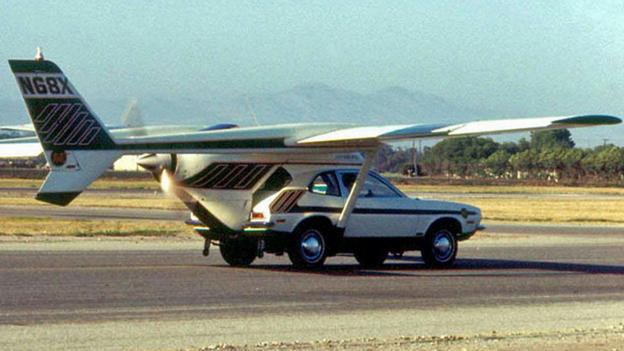- Death drive
- The AVE Mizar, a flying car, killed its inventor in a crash in 1973. It’s one of many notorious failed inventions, compiled in the following gallery. (Wikimedia Commons)
It’s easy to dismiss or laugh at ideas that never take off, but failure plays a vital role in shaping the devices that rule our lives, as Richard Fisher discovers.
Timothy Prestero expected big things from his idea. He believed it would save the lives of millions of children worldwide – and he wasn’t alone. It came top of the list in Time magazine’s 50 best inventions of the year. So when it flopped spectacularly, it was tough to accept.
Prestero built a device called the NeoNuture, a baby incubator made from miscellaneous car parts and other nuts-and-bolts. Unlike expensive hi-tech incubators, the NeoNurture was powered by a motorcycle battery, used headlights for heat and had a door chime for an alarm. This made it ideal for hospitals in rural Africa and other parts of the developing world where repair parts are hard to come by. It won praise and plaudits worldwide. And then... nothing. Why did the NeoNature never get beyond a prototype?
The answer was revealed at a recent exhibition called Fail Better, at Dublin’s Science Gallery in Ireland. The story of the NeoNurture joined contributions by inventors, athletes, explorers and even astrophysicists, who each submitted an object they thought characterised the theme of failure. It is a compendium of quashed dreams, acts of stupidity, serendipitous success, and crucially, instructive lessons about the true nature of failure.

The NeoNurture incubator was hailed as ‘genius’, but failed to catch on in hospitals (Design That Matters)
Browse any patent library, and you’ll find countless gizmos that never made it off the drawing board. Marc Abrahams, who founded the Ig Nobel prize, suggested one of these wacky creations – the “Apparatus for facilitating childbirth by centrifugal force”, invented by George and Charlotte Blonsky in 1965. Abrahams describes how it works: “When a woman is ready to deliver her child, she lies back on a circular table. She is strapped down. The table is then rotated at high speed. The baby comes flying out.” Perhaps unsurprisingly, it didn’t catch on.

This device for facilitating childbirth was designed to spin, using centrifugal force to encourage the baby to emerge (Fail Better)
Then there are the technologies that failed due to catastrophic human error. Astrophysicist Jocelyn Bell Burnell nominated the Mars Climate Orbiter, which famously was lost in space due to a mix-up over imperial and metric units. One bit of software used pounds to calculate the force the thrusters needed to exert, while another used Newtons. As a result, the orbiter disintegrated in the Mars atmosphere, leaving everybody scratching their head about how such a big error could be missed.

What the Mars Climate Orbiter would have looked like if a huge blunder hadn’t made it crash into the Martian atmosphere (SPL)
In a similar vein of incredulity, journalist Oliver Wainwright nominated the“Walkie-Talkie” building in London, which has a concave shape that was found to concentrate the sun’s rays enough to melt the rubber on cars in the street below. What made it all the more curious, says Wainwright, was that the architect had encountered almost exactly the same problem with a hotel he designed in Las Vegas.

The concave shape of the Walkie Talkie building in London focused the sun’s rays enough to melt rubber in the street below (AFP)
It would be easy to confine failure to the bad, the foolish, and the plain wrong. But in fact it comes in many forms, and “we wanted to celebrate the complexity of failure”, says curator Jane Ní Dhulchaointigh, who invented the (rather successful) material Sugru, a self-setting rubber for repairs in the home. In technology, there’s a “myth of the overnight success”, but the reality is quite different.
Take Prestero’s NeoNurture incubator. In 2010, Time magazine called it “genius” in its list of the year’s best inventions. In the wake of all the plaudits, Prestero tried to launch his innovative incubator to the developing world. It was only then that he encountered an all-too human reality.
“Every doctor and hospital administrator in the world who has seen [the TV show] ER knows what a medical device should look like,” explains Prestero, “They don’t want effective technology that looks like it’s made from car parts. It sounds crazy but some hospitals would rather have no equipment than something that looks cheap and crummy.”
The first lesson of failure for engineers and designers, then, is that the adoption of technology is governed by existing cultural norms. “There are no dumb users, only dumb products,” says Prestero.
Reassuringly, though, the history of flops in tech would suggest that even if Prestero faltered, others in his footsteps might not. And this gets to the interesting and vital role that failure plays in shaping the devices that rule our lives. No technology that changes the world comes from nowhere – almost all great inventions are built on a series of failed prototypes and previous iterations made by others that weren’t quite ready to take off. Before the iPod, there was the Listen Up mp3 player; before Facebook, there was Friendster, and before DVDs, there were Laserdiscs. Blame timing, bad luck or the human foibles of their inventors – the point is that these turkeys made it a little bit easier for those that followed.
In fact, this is the story of invention. While we hold up our visionaries and their lightbulb moments, the day-to-day reality of inventing is continual, depressing defeat. British inventor James Dyson, for instance, points out that it took him 5,127 prototypes to develop his first bagless vacuum cleaner. Inventors and scientists must “carry failure” with them all the time, says Ní Dhulchaointigh.

Installation at the Dublin Science Gallery inspired by the serendipitous discovery of the colour mauve (Fail Better)
Fortunately, such perseverance occasionally brings unexpected success. The educator Ken Robinson describes in his submission how the synthetic dye mauve was discovered. In 1856, William Perkin was experimenting with coal tar, trying to develop a synthetic version of the medicinal substance quinine. Day after day, he kept failing. Then one night, the light from his lamp shone through the edge of his beaker, scattering into a brilliant purple hue. The new colour went down a storm, and Perkin went on to found the synthetic dye industry. Serendipitous success only came from living with persistent setbacks.
So should failure always be embraced? Not quite, says Ní Dhulchaointigh. There’s a mantra bandied around in Silicon Valley, for example: “Fail fast, fail early, fail often”. “It’s almost a badge of honour in the start-up world,” she says. “In a way it’s problematic. It could result in mediocre work.”
Still, when we talk about technology and the way it shapes our lives, it is worth remembering that every invention that changed the world was built on the work of a thousand failed inventors, and a thousand failed ideas.
































